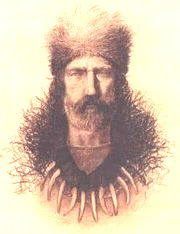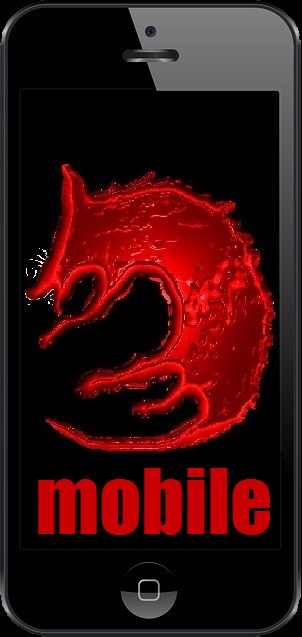
Hugh Glass
Hugh Glass was a Mountain man by trade, he was an Irishman raised by Pawnee Indians who wandered the countryside lending his services to various expeditions that required fearless frontiersmen to "scout" (meaning you made sure everything was safe for the people who were going to take credit).
In August 1823, an aged Hugh Glass responded to an advertisement in the Missouri Gazette and began scouting for a fur trapping expedition in South Dakota when he came across a grizzly bear mother and her two cubs. The mother immediately charged him, knocking his rifle out of his hands and mauling him. Glass drew his knife and fought the grizzly hand-to-hand stabbing it repeatedly as it clawed and gnawed him apart. Hearing his screams, two trapping partners arrived and found the two in a bloody mess, Glass unconscious and both apparently mortally wounded. They finished off the dying bear with a rifle shot to the head, then carried Glass back to their camp. Expedition leader Andrew Henry (Sure Glass would not survive) asked two trappers, Jim Bridger and John Fitzgerald, to stay with Glass until he died and give him an honorable burial . Glass was covered in blood, his scalp, face, chest, arms, hand and leg were shredded. The bear had chewed into his shoulder and back to the bone. Bridger and Fitzgerald were to gave him a good burial then catch up and rejoin the group.
The two waited and watched the dying Glass. They became impatient and covered Glass, who was laboring but still breathing with the bare skin, took his rifle, knife, and gear and left him. It would later be reported that Fitzgerald worried they might not catch up with the expedition. They caught up to the rest of the group heading to Yellowstone and reported that Hugh Glass was dead (Later, the changed their story claiming that they fled while digging the grave after hostile "Arikaree" Indians discovered them, but there is no evidence).
However, Glass woke up in his shallow grave, under a thin layer of dirt and leaves. All his weapons, equipment, and protective clothing had been taken by the two men. His leg was broken, he had exposed rib bones on his back, and he had lost a critical amount of blood, The bear had nearly torn off his scalp, His wounds were festering. Alone and defenseless, he was more than 200 miles away from the nearest settlement, Fort Kiowa. He set his own broken leg, wrapped himself in the bear hide, and started crawling.
It took Glass six weeks of crawling on his hands and knees to reach the Cheyenne River, 100 miles away from the grave. He suffered from fever and advanced stages of infection. To prevent gangrene from progressing into his wounds on his back, he allowed maggots that he found on dead logs to eat the dead flesh away. He survived mostly on wild berries, roots, and other edible plants and on one occasion he was able to scare wolves away from a bison they had killed, and ate the raw meat. When he finally reached the Cheyenne river, he built a raft from a large fallen tree and floated down the river. Along the way he encountered friendly Sioux who fed him and tended to his wounds, primarily by sewing the bear hide to his back to cover his exposed wounds. Eventually he succeeded in floating in his dead tree all the way to Fort Kiowa.
Hugh Glass claimed he was motivated by revenge to survive. After a couple months of recovery at Fort Kiowa, he set out to kill the two men who had abandoned him. Glass found Jim Bridger at a trading post on the Yellowstone river. Bridger was only 19 years old at the time, Glass forgave him because of his age, believing his conscience would be his punishment. He set out to find the older (and more responsible) Fitzgerald. Less then a year after the ordeal he found John Fitzgerald, who had joined the US Army, confronting him in Fort Atkinson, Wisconsin. At that time the penalty for killing a Soldier was death, Glass gave up on his mission of vengeance and spared Fitzgerald’s life as well. He accepted money collected by other soldiers who sympathized with his story, and he recovered his stolen rifle from Fitzgerald, and Glass walked away. Glass continued to be a trapper, fur trader, and hunter by profession until he was finally killed in an Indian attack in 1833 (same rifle in hand).
The two waited and watched the dying Glass. They became impatient and covered Glass, who was laboring but still breathing with the bare skin, took his rifle, knife, and gear and left him. It would later be reported that Fitzgerald worried they might not catch up with the expedition. They caught up to the rest of the group heading to Yellowstone and reported that Hugh Glass was dead (Later, the changed their story claiming that they fled while digging the grave after hostile "Arikaree" Indians discovered them, but there is no evidence).
However, Glass woke up in his shallow grave, under a thin layer of dirt and leaves. All his weapons, equipment, and protective clothing had been taken by the two men. His leg was broken, he had exposed rib bones on his back, and he had lost a critical amount of blood, The bear had nearly torn off his scalp, His wounds were festering. Alone and defenseless, he was more than 200 miles away from the nearest settlement, Fort Kiowa. He set his own broken leg, wrapped himself in the bear hide, and started crawling.
It took Glass six weeks of crawling on his hands and knees to reach the Cheyenne River, 100 miles away from the grave. He suffered from fever and advanced stages of infection. To prevent gangrene from progressing into his wounds on his back, he allowed maggots that he found on dead logs to eat the dead flesh away. He survived mostly on wild berries, roots, and other edible plants and on one occasion he was able to scare wolves away from a bison they had killed, and ate the raw meat. When he finally reached the Cheyenne river, he built a raft from a large fallen tree and floated down the river. Along the way he encountered friendly Sioux who fed him and tended to his wounds, primarily by sewing the bear hide to his back to cover his exposed wounds. Eventually he succeeded in floating in his dead tree all the way to Fort Kiowa.
Hugh Glass claimed he was motivated by revenge to survive. After a couple months of recovery at Fort Kiowa, he set out to kill the two men who had abandoned him. Glass found Jim Bridger at a trading post on the Yellowstone river. Bridger was only 19 years old at the time, Glass forgave him because of his age, believing his conscience would be his punishment. He set out to find the older (and more responsible) Fitzgerald. Less then a year after the ordeal he found John Fitzgerald, who had joined the US Army, confronting him in Fort Atkinson, Wisconsin. At that time the penalty for killing a Soldier was death, Glass gave up on his mission of vengeance and spared Fitzgerald’s life as well. He accepted money collected by other soldiers who sympathized with his story, and he recovered his stolen rifle from Fitzgerald, and Glass walked away. Glass continued to be a trapper, fur trader, and hunter by profession until he was finally killed in an Indian attack in 1833 (same rifle in hand).



